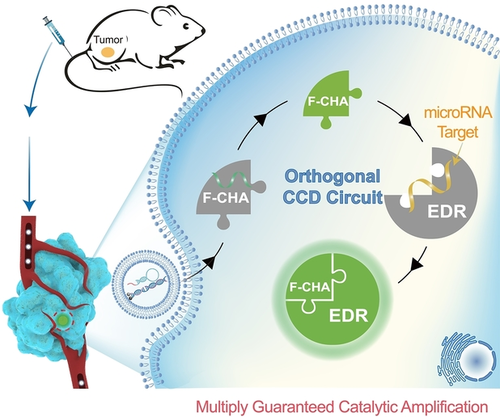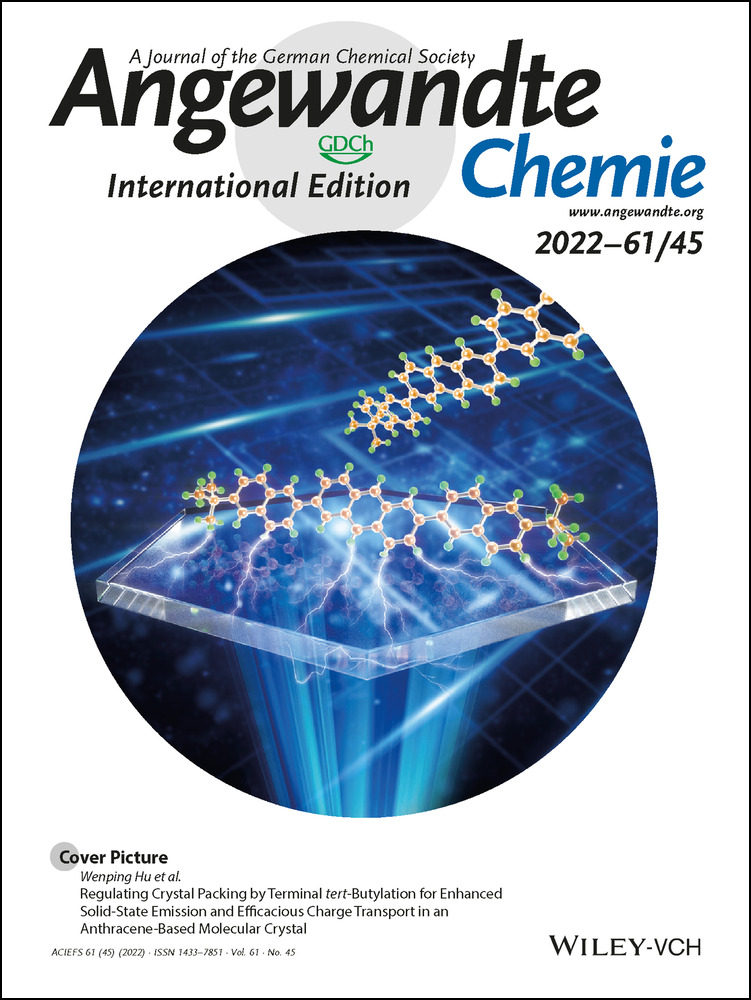On-Site Non-enzymatic Orthogonal Activation of a Catalytic DNA Circuit for Self-Reinforced In Vivo MicroRNA Imaging
Shizhen He
College of Chemistry and Molecular Sciences, Wuhan University, Wuhan, P. R. China
Search for more papers by this authorShanshan Yu
College of Chemistry and Molecular Sciences, Wuhan University, Wuhan, P. R. China
Search for more papers by this authorRuomeng Li
College of Chemistry and Molecular Sciences, Wuhan University, Wuhan, P. R. China
Search for more papers by this authorYingying Chen
College of Chemistry and Molecular Sciences, Wuhan University, Wuhan, P. R. China
Search for more papers by this authorQing Wang
College of Chemistry and Molecular Sciences, Wuhan University, Wuhan, P. R. China
Search for more papers by this authorYuqiu He
College of Chemistry and Molecular Sciences, Wuhan University, Wuhan, P. R. China
Search for more papers by this authorProf. Xiaoqing Liu
College of Chemistry and Molecular Sciences, Wuhan University, Wuhan, P. R. China
Search for more papers by this authorCorresponding Author
Prof. Fuan Wang
College of Chemistry and Molecular Sciences, Wuhan University, Wuhan, P. R. China
Department of Gastrointestinal Surgery, Zhongnan Hospital of Wuhan University, Wuhan, P. R. China
Research Centre for Infectious Diseases and Cancer, Chinese Academy of Medical Sciences, Wuhan, P. R. China
Search for more papers by this authorShizhen He
College of Chemistry and Molecular Sciences, Wuhan University, Wuhan, P. R. China
Search for more papers by this authorShanshan Yu
College of Chemistry and Molecular Sciences, Wuhan University, Wuhan, P. R. China
Search for more papers by this authorRuomeng Li
College of Chemistry and Molecular Sciences, Wuhan University, Wuhan, P. R. China
Search for more papers by this authorYingying Chen
College of Chemistry and Molecular Sciences, Wuhan University, Wuhan, P. R. China
Search for more papers by this authorQing Wang
College of Chemistry and Molecular Sciences, Wuhan University, Wuhan, P. R. China
Search for more papers by this authorYuqiu He
College of Chemistry and Molecular Sciences, Wuhan University, Wuhan, P. R. China
Search for more papers by this authorProf. Xiaoqing Liu
College of Chemistry and Molecular Sciences, Wuhan University, Wuhan, P. R. China
Search for more papers by this authorCorresponding Author
Prof. Fuan Wang
College of Chemistry and Molecular Sciences, Wuhan University, Wuhan, P. R. China
Department of Gastrointestinal Surgery, Zhongnan Hospital of Wuhan University, Wuhan, P. R. China
Research Centre for Infectious Diseases and Cancer, Chinese Academy of Medical Sciences, Wuhan, P. R. China
Search for more papers by this authorGraphical Abstract
A non-enzymatically and orthogonally controlled catalytic DNA (CCD) circuit was prepared for on-site and efficient in vivo microRNA (miRNA) imaging without off-site signal leakage. The CCD circuit integrates the cell-specific endogenous stimulation of the auxiliary catalytic hairpin assembly (CHA) with the orthogonal activation of the main entropy-driven DNA reaction (EDR) for sensitive target detection.
Abstract
The wide extracellular-intracellular distribution of microRNA requires the on-site, robust and efficient activation of catalytic DNA circuits inside live cells. Herein, we develop an efficient non-enzymatic circuitry activation strategy to realize the orthogonally controlled catalytic DNA (CCD) circuit for achieving high-fidelity in vivo microRNA imaging through multiply guaranteed molecular recognition and progressively accelerated signal amplification. For predictable on-site activation and useful catalytic efficiency, the dominating circuitry fuel strand was initially split into inactive fuel subunits that were grafted into an auxiliary catalytic circuit. There, the in-cell-specific mRNA triggered the orthogonal amplification of the active fuel strands for sensitive target detection through the chief entropy-driven catalytic DNA circuit. We believe that the on-site orthogonal circuitry activation method can contribute to clinical diagnosis and prognosis.
Conflict of interest
The authors declare no conflict of interest.
Open Research
Data Availability Statement
The data that support the findings of this study are available in the Supporting Information of this article.
Supporting Information
As a service to our authors and readers, this journal provides supporting information supplied by the authors. Such materials are peer reviewed and may be re-organized for online delivery, but are not copy-edited or typeset. Technical support issues arising from supporting information (other than missing files) should be addressed to the authors.
| Filename | Description |
|---|---|
| anie202206529-sup-0001-misc_information.pdf6.1 MB | Supporting Information |
Please note: The publisher is not responsible for the content or functionality of any supporting information supplied by the authors. Any queries (other than missing content) should be directed to the corresponding author for the article.
References
- 1
- 1aN. Srinivas, J. Parkin, G. Seelig, E. Winfree, D. Soloveichik, Science 2017, 358, eaal2052;
- 1bD. Bray, Nature 1995, 376, 307–312;
- 1cJ. J. Tyson, K. C. Chen, B. Novak, Curr. Opin. Cell Biol. 2003, 15, 221–231;
- 1dS. Fan, J. Cheng, Y. Liu, D. Wang, T. Luo, B. Dai, C. Zhang, D. Cui, Y. Ke, J. Song, J. Am. Chem. Soc. 2020, 142, 14566–14573.
- 2
- 2aD. Y. Zhang, G. Seelig, Nat. Chem. 2011, 3, 103–113;
- 2bJ. Santa Lucia, Jr., D. Hicks, Annu. Rev. Astron. Astrophys. 2004, 33, 415–440;
- 2cF. C. Simmel, B. Yurke, H. R. Singh, Chem. Rev. 2019, 119, 6326–6369;
- 2dW. Yu, J. Sun, F. Liu, S. Yu, Z. Xu, F. Wang, X. Liu, ACS Appl. Mater. Interfaces 2020, 12, 17167–17176.
- 3
- 3aF. Li, H. Zhang, Z. Wang, X. Li, X. F. Li, X. C. Le, J. Am. Chem. Soc. 2013, 135, 2443–2446;
- 3bT. Fu, Y. Lyu, H. Liu, R. Peng, X. Zhang, M. Ye, W. Tan, Trends Biochem. Sci. 2018, 43, 547–560;
- 3cA. J. Genot, A. Baccouche, R. Sieskind, N. Aubert-Kato, N. Bredeche, J. F. Bartolo, V. Taly, T. Fujii, Y. Rondelez, Nat. Chem. 2016, 8, 760–767;
- 3dY. Hu, Y. Wang, J. Yan, N. Wen, H. Xiong, S. Cai, Q. He, D. Peng, Z. Liu, Y. Liu, Adv. Sci. 2020, 7, 2000557;
- 3eC. Xue, S. X. Zhang, C. H. Ouyang, D. Chang, B. J. Salena, Y. Li, Z. S. Wu, Angew. Chem. Int. Ed. 2018, 57, 9739–9743; Angew. Chem. 2018, 130, 9887–9891;
- 3fY. Lu, J. W. Liu, Acc. Chem. Res. 2007, 40, 315–323.
- 4
- 4aH. Ravan, M. Amandadi, M. Hassanshahian, S. Pourseyedi, Int. J. Biol. Macromol. 2020, 154, 896–903;
- 4bJ. Yang, R. Wu, Y. Li, Z. Wang, L. Pan, Q. Zhang, Z. Lu, C. Zhang, Nucleic Acids Res. 2018, 46, 8532–8541;
- 4cJ. Feng, Z. Xu, F. Liu, Y. Zhao, W. Yu, M. Pan, F. Wang, X. Liu, ACS Nano 2018, 12, 12888–12901.
- 5
- 5aD. Y. Zhang, Science 2009, 326, 1633–1633;
- 5bL. He, D. Lu, H. Liang, S. Xie, X. Zhang, Q. Liu, Q. Yuan, W. Tan, J. Am. Chem. Soc. 2018, 140, 258–263;
- 5cC. P. Liang, P. Q. Ma, H. Liu, X. Guo, B. C. Yin, B. C. Ye, Angew. Chem. Int. Ed. 2017, 56, 9077–9081; Angew. Chem. 2017, 129, 9205–9209;
- 5dX. He, T. Zeng, Z. Li, G. Wang, N. Ma, Angew. Chem. Int. Ed. 2016, 55, 3073–3076; Angew. Chem. 2016, 128, 3125–3128.
- 6
- 6aD. Kim, Q. Wei, D. H. Kim, D. Tseng, J. Zhang, E. Pan, O. Garner, A. Ozcan, D. Di Carlo, Anal. Chem. 2018, 90, 690–695;
- 6bH. Li, M. Han, X. Weng, Y. Zhang, J. Li, ACS Nano 2021, 15, 1710–1717;
- 6cJ. Li, J. Wang, S. Liu, N. Xie, K. Quan, Y. Yang, X. Yang, J. Huang, K. Wang, Angew. Chem. Int. Ed. 2020, 59, 20104–20111; Angew. Chem. 2020, 132, 20279–20286;
- 6dC. Zhang, Z. Wang, Y. Liu, J. Yang, X. Zhang, Y. Li, L. Pan, Y. Ke, H. Yan, J. Am. Chem. Soc. 2019, 141, 17189–17197;
- 6eM. Bai, F. Chen, X. Cao, Y. Zhao, J. Xue, X. Yu, C. Fan, Y. Zhao, Angew. Chem. Int. Ed. 2020, 59, 13267–13272; Angew. Chem. 2020, 132, 13369–13374;
- 6fF. Liu, N. Li, Y. Shang, Y. Wang, Q. Liu, Z. Ma, Q. Jiang, B. Ding, Angew. Chem. Int. Ed. 2022, 61, e202114706; Angew. Chem. 2022, 134, e202114706.
- 7
- 7aT. Song, N. Gopalkrishnan, A. Eshra, S. Garg, R. Mokhtar, H. Bui, H. Chandran, J. Reif, ACS Nano 2018, 12, 11689–11697;
- 7bX. Olson, S. Kotani, J. E. Padilla, N. Hallstrom, S. Goltry, J. Lee, B. Yurke, W. L. Hughes, E. Graugnard, ACS Synth. Biol. 2017, 6, 84–93;
- 7cX. Gong, H. Wang, R. Li, K. Tan, J. Wei, J. Wang, C. Hong, J. Shang, X. Liu, J. Liu, F. Wang, Nat. Commun. 2021, 12, 3953.
- 8
- 8aY. Shao, J. Zhao, J. Yuan, Y. Zhao, L. Li, Angew. Chem. Int. Ed. 2021, 60, 8923–8931; Angew. Chem. 2021, 133, 9005–9013;
- 8bY. S. Mi, J. Zhao, H. Q. Chu, Z. X. Li, M. M. Yu, L. L. Li, Anal. Chem. 2021, 93, 2500–2509.
- 9
- 9aD. Yi, J. Zhao, L. Li, Angew. Chem. Int. Ed. 2021, 60, 6300–6304; Angew. Chem. 2021, 133, 6370–6374;
- 9bJ. Zhao, Z. Li, Y. Shao, W. Hu, L. Li, Angew. Chem. Int. Ed. 2021, 60, 17937–17941; Angew. Chem. 2021, 133, 18081–18085;
- 9cJ. Zhao, J. Gao, W. Xue, Z. Di, H. Xing, Y. Lu, L. Li, J. Am. Chem. Soc. 2018, 140, 578–581;
- 9dQ. Wang, K. Tan, H. Wang, J. Shang, Y. Wan, X. Liu, X. Weng, F. Wang, J. Am. Chem. Soc. 2021, 143, 6895–6904.
- 10Y. Zhao, F. Chen, Q. Li, L. Wang, C. Fan, Chem. Rev. 2015, 115, 12491–12545.
- 11D. M. Kolpashchikov, Chem. Rev. 2010, 110, 4709–4723.
- 12
- 12aP. Yin, H. M. Choi, C. R. Calvert, N. A. Pierce, Nature 2008, 451, 318–322;
- 12bH. Wang, Y. He, J. Wei, H. Wang, K. Ma, Y. Zhou, X. Liu, X. Zhou, F. Wang, Angew. Chem. Int. Ed. 2022, 61, e202115489; Angew. Chem. 2022, 134, e202115489.
- 13
- 13aB. Li, A. D. Ellington, X. Chen, Nucleic Acids Res. 2011, 39, e110;
- 13bX. Chen, N. Briggs, J. R. McLain, A. D. Ellington, Proc. Natl. Acad. Sci. USA 2013, 110, 5386–5391;
- 13cY. Jiang, B. L. Li, J. N. Milligan, S. Bhadra, A. D. Ellington, J. Am. Chem. Soc. 2013, 135, 7430–7433.
- 14
- 14aR. J. Deng, K. X. Zhang, J. H. Li, Acc. Chem. Res. 2017, 50, 1059–1068;
- 14bH. Y. Peng, A. M. Newbigging, M. S. Reid, J. S. Uppal, J. Y. Xu, H. Q. Zhang, X. C. Le, Anal. Chem. 2020, 92, 292–308.
- 15Z. Luo, Z. Huang, K. Li, Y. Sun, J. Lin, D. Ye, H. Y. Chen, Anal. Chem. 2018, 90, 2875–2883.
- 16
- 16aC. C. Chen, T. W. Chang, F. M. Chen, M. F. Hou, S. Y. Hung, I. W. Chong, S. C. Lee, T. H. Zhou, S. R. Lin, Oncology 2006, 70, 438–446;
- 16bY. J. Yang, J. Huang, X. H. Yang, K. Quan, H. Wang, L. Ying, N. L. Xie, M. Ou, K. M. Wang, J. Am. Chem. Soc. 2015, 137, 8340–8343;
- 16cX. Gao, S. Li, F. Ding, H. Fan, L. Shi, L. Zhu, J. Li, J. Feng, X. Zhu, C. Zhang, Angew. Chem. Int. Ed. 2019, 58, 8719–8723; Angew. Chem. 2019, 131, 8811–8815.
- 17
- 17aN. Li, C. Chang, W. Pan, B. Tang, Angew. Chem. Int. Ed. 2012, 51, 7426–7430; Angew. Chem. 2012, 124, 7544–7548;
- 17bY. F. Jiang, X. Xu, X. Fang, S. X. Cai, M. Wang, C. Xing, C. H. Lu, H. H. Yang, Anal. Chem. 2020, 92, 11779–11785;
- 17cF. Yang, T. T. Zhang, S. S. Li, P. Song, K. Zhang, Q. Y. Guan, B. Kang, J. J. Xu, H. Y. Chen, Anal. Chem. 2017, 89, 10239–10247;
- 17dK. Shi, B. Dou, C. Yang, Y. Chai, R. Yuan, Y. Xiang, Anal. Chem. 2015, 87, 8578–8583.





